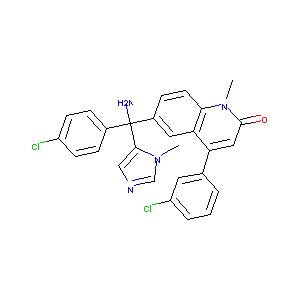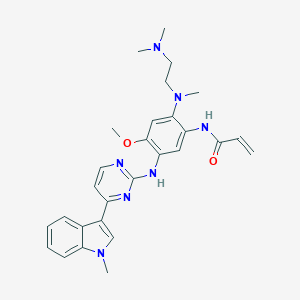| 1 |
ClinicalTrials.gov (NCT05693090) Tipifarnib and Osimertinib in EGFR-mutated Non-Small Cell Lung Cancer
|
| 2 |
ClinicalTrials.gov (NCT00093990) Tipifarnib Versus Best Supportive Care in the Treatment of Newly Diagnosed Acute Myeloid Leukemia (AML). U.S. National Institutes of Health.
|
| 3 |
Clinical pipeline report, company report or official report of the Pharmaceutical Research and Manufacturers of America (PhRMA)
|
| 4 |
Emerging therapies for multiple myeloma. Expert Opin Emerg Drugs. 2009 Mar;14(1):99-127.
|
| 5 |
The ChEMBL database in 2017. Nucleic Acids Res. 2017 Jan 4;45(D1):D945-D954.
|
| 6 |
URL: http://www.guidetopharmacology.org Nucleic Acids Res. 2015 Oct 12. pii: gkv1037. The IUPHAR/BPS Guide to PHARMACOLOGY in 2016: towards curated quantitative interactions between 1300 protein targets and 6000 ligands. (Ligand id: 7719).
|
| 7 |
Tipifarnib in the treatment of newly diagnosed acute myelogenous leukemia. Biologics. 2008 Sep;2(3):491-500.
|
| 8 |
Farnesyltransferase inhibitor R115777 (Zarnestra, Tipifarnib) synergizes with paclitaxel to induce apoptosis and mitotic arrest and to inhibit tumor growth of multiple myeloma cells. Blood. 2005 Jun 15;105(12):4759-66. doi: 10.1182/blood-2004-11-4307. Epub 2005 Feb 22.
|
| 9 |
Genetic disruption of the PI3K regulatory subunits, p85, p55, and p50, normalizes mutant PTPN11-induced hypersensitivity to GM-CSF. Haematologica. 2012 Jul;97(7):1042-7. doi: 10.3324/haematol.2011.046896. Epub 2012 Feb 7.
|
| 10 |
Ras homologue enriched in brain is a critical target of farnesyltransferase inhibitors in non-small cell lung cancer cells. Cancer Lett. 2010 Nov 1;297(1):117-25. doi: 10.1016/j.canlet.2010.05.004.
|
| 11 |
Pharmacogenetics of tipifarnib (R115777) transport and metabolism in cancer patients. Invest New Drugs. 2004 Aug;22(3):285-9.
|
| 12 |
In vitro inhibition of human UDP-glucuronosyltransferase (UGT) 1A1 by osimertinib, and prediction of in vivo drug-drug interactions. Toxicol Lett. 2021 Sep 15;348:10-17. doi: 10.1016/j.toxlet.2021.05.004. Epub 2021 May 24.
|
| 13 |
Targeting the EMT transcription factor TWIST1 overcomes resistance to EGFR inhibitors in EGFR-mutant non-small-cell lung cancer. Oncogene. 2019 Jan;38(5):656-670. doi: 10.1038/s41388-018-0482-y. Epub 2018 Aug 31.
|
| 14 |
AZD9291, an irreversible EGFR TKI, overcomes T790M-mediated resistance to EGFR inhibitors in lung cancer. Cancer Discov. 2014 Sep;4(9):1046-61.
|
| 15 |
Dihydromyricetin suppresses tumor growth via downregulation of the EGFR/Akt/survivin signaling pathway. J Biochem Mol Toxicol. 2023 Jun;37(6):e23328. doi: 10.1002/jbt.23328. Epub 2023 Feb 19.
|
| 16 |
Osimertinib induces autophagy and apoptosis via reactive oxygen species generation in non-small cell lung cancer cells. Toxicol Appl Pharmacol. 2017 Apr 15;321:18-26. doi: 10.1016/j.taap.2017.02.017. Epub 2017 Feb 22.
|
| 17 |
Cytotoxicity of 34 FDA approved small-molecule kinase inhibitors in primary rat and human hepatocytes. Toxicol Lett. 2018 Jul;291:138-148. doi: 10.1016/j.toxlet.2018.04.010. Epub 2018 Apr 12.
|
| 18 |
Dictamnine, a novel c-Met inhibitor, suppresses the proliferation of lung cancer cells by downregulating the PI3K/AKT/mTOR and MAPK signaling pathways. Biochem Pharmacol. 2022 Jan;195:114864. doi: 10.1016/j.bcp.2021.114864. Epub 2021 Nov 30.
|
| 19 |
AZD9291 promotes autophagy and inhibits PI3K/Akt pathway in NSCLC cancer cells. J Cell Biochem. 2019 Jan;120(1):756-767. doi: 10.1002/jcb.27434. Epub 2018 Aug 26.
|
|
|
|
|
|
|


